Plymouth Belvedere
| Plymouth Belvedere | |
|---|---|
 1958 Plymouth Belvedere 2-door hardtop | |
| Overview | |
| Manufacturer | Plymouth (Chrysler) |
| Production | 1954–1970 |
| Assembly |
|
| Body and chassis | |
| Class | Full-size (1954–1964) Mid-size (1965–1970) |
| Layout | FR layout |
| Chronology | |
| Predecessor | Plymouth Cranbrook |
| Successor | Plymouth Satellite |
Plymouth Belvedere is a series of American automobile models made by Plymouth from 1954 to 1970.[1] The Belvedere name was first used for a new hardtop body style in the Plymouth Cranbrook line for the 1951 model year. In 1954 the Belvedere replaced the Cranbrook as the top trim and became a full model line with sedans, station wagons and convertible body styles. The Belvedere continued as Plymouth's full-sized car until 1965, when it became an intermediate, and was replaced after the 1970 model year by the Satellite, a name originally used for the top-trim level Belvederes. The nameplate "belvedere" is Italian for "beautiful sight" or “fair view”. Chrysler also had the Belvidere Assembly Plant in Belvidere, Illinois which began production in 1965.
Cranbrook Belvedere 1951–1953[]
| Plymouth Cranbrook Belvedere | |
|---|---|
 | |
| Overview | |
| Also called | Dodge Regent (Canada) |
| Model years | 1951-1953 |
| Assembly | Lynch Road Assembly, Highland Park, Michigan Los Angeles Assembly, Maywood, California |
| Body and chassis | |
| Class | Full-size car |
| Body style | 2-door hardtop[2] |
| Related | DeSoto Custom Dodge Custom |
| Powertrain | |
| Engine | 218 cu in (3.6 L) Chrysler Flathead I6 |
| Dimensions | |
| Wheelbase | 114.0 in (2,896 mm) |
Introduced on March 31, the 1951 Plymouth Cranbrook Belvedere is a two-door pillarless hardtop. It was Plymouth's first such body design and was introduced in response to the 1950 Chevrolet Bel Air, and the Ford Victoria, the first two-door hardtop in the low-priced American market.
The Cranbook Belvedere was the name for the two-door hardtop version of the Cranbrook and built on the same 118.5 in (3,010 mm) wheelbase. Powering the Belvedere is the Chrysler flathead 217.8 cu in (3.6 L) straight-6 engine with a 7.00:1 compression ratio producing 97 hp (72 kW; 98 PS) (SAE gross).
Plymouth used the name Savoy on several automobiles. From 1951-1953, the Savoy name was used on a station wagon, upgrading the base model Suburban. Later was a line of full-sized Plymouths from 1954-1961.[1]
For 1952, Plymouth kept the Cranbrook Belvedere largely unchanged. The biggest alteration was to the color scheme; to further distinguish the top-level Belvedere from other Plymouths, the two tones now flowed from the roof over the beltline onto the trunk, which has been referred to as the "saddleback" treatment. Two-tone color schemes were "sable bronze" over suede, black over "mint green", and gray over blue. Overdrive was made available as optional equipment in the 1952 Plymouth. In overdrive, the engine made three revolutions for each rear wheel revolution and four without overdrive. The engine was a complete carryover from 1951. Production for 1951 and 1952 totaled 51,266 units.
The Belvedere remained a part of the Cranbrook series through the 1953 model year, which saw all Plymouth models completely restyled. Major style changes include a shorter 114 in (2,900 mm) wheelbase, a one-piece windshield, flush rear fenders, and a lower hood line. In April 1953, Plymouths received the Hy-Drive semi-automatic transmission. The engine was carried over from 1952 with the only enhancement being a slight increase in the compression ratio to 7.10:1, which yielded a rating of 100 hp (75 kW).
A total of 35,185 Belvederes were sold in 1953.
Full-size series[]
1954[]
| First generation | |
|---|---|
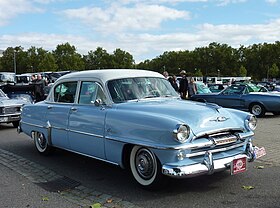 1954 Plymouth Belvedere four door sedan | |
| Overview | |
| Model years | 1954 |
| Assembly | Lynch Road Assembly, Highland Park, Michigan Los Angeles Assembly, Maywood, California |
| Body and chassis | |
| Class | Full-size car |
| Body style | 4-door sedan[3] 2-door hardtop[3] 2-door convertible[3] 2-door station wagon[3] |
| Related | DeSoto Firedome Dodge Meadowbrook |
| Powertrain | |
| Engine | 230 cu in (3.8 L) I6 |
| Dimensions | |
| Wheelbase | 114.0 in (2,896 mm) |
The Belvedere replaced the Cranbrook as the top-line offering for 1954. Now, a separate model instead of just a two-door hardtop, it was also available as a convertible, two-door station wagon, and four-door sedan. The two-door hardtop version was now called the "Sport Coupe". The 1954 Belvederes featured full-length rocker sill moldings.[3]
Minor styling updates adorned the carry-over body design. For the first time, small chrome tailfins appeared on the rear fenders. An entry level nameplate was introduced, called the Plymouth Plaza sharing the essential technology while priced more modestly.
In March 1954, Plymouth finally offered a fully automatic transmission, the Chrysler PowerFlite two-speed. Also new was a larger standard engine: a 230.2 cu in (3.8 L) I6 that was also used by the Dodge Division. Power was now rated at 110 hp (82 kW).
Belvedere production totaled 32,492 for the year. In 1954, the Savoy was available as a two-door Club Coupe, four-door sedan, and 2-door Club Sedan.[4]

1954 Plymouth Belvedere four-door sedan

1954 Plymouth Belvedere Suburban

1954 Plymouth Plaza 2-door Suburban
1954 Plymouth Savoy Sedan rear view
1955–1956[]
| Second generation | |
|---|---|
 1955 Plymouth Belvedere 4-door sedan | |
| Overview | |
| Also called | Dodge Mayfair (Canada) |
| Model years | 1955–1956 |
| Assembly | Lynch Road Assembly, Highland Park, Michigan Los Angeles Assembly, Maywood, California |
| Body and chassis | |
| Body style | 2-door sedan[5] 4-door sedan[5] 2-door hardtop[5] 4-door hardtop[5] 2-door convertible[5] 4-door station wagon[5] |
| Related | DeSoto Powermaster Dodge Coronet |
| Powertrain | |
| Engine | 230 cu in (3.8 L) I6 241 cu in (3.9 L) V8 260 cu in (4.3 L) V8 277 cu in (4.5 L) V8 303 cu in (5.0 L) V8 |
| Transmission | 2-speed automatic |
| Dimensions | |
| Wheelbase | 115.0 in (2,921 mm) |
All Plymouths were treated to a major overhaul for the 1955 model year. This was the first year of Chrysler stylist Virgil Exner's "Forward Look." The Belvedere returned as top-of-the-line, and the Plaza remained the entry level model. When introduced in 1954, later in the year with 1955 model paint schemes, the Savoy was Plymouth's mid-level car. Chrysler promoted the all new appearance, showing cars built at the Lynch Road Factory in a featurette movie Here. Midway through the model year (on February 26), the engine's stroke was increased by a quarter inch, increasing displacement from 217.8 to 230.2 cu in (3.6 to 3.8 L) and increasing power from 100 to 110 hp (75 to 82 kW).[6]
For 1956, Plymouth styling evolved from that of the 1955s. Most notable would be the introduction of the first push-button automatic transmission to appear in an American automobile, and a more dramatic rear-end treatment highlighted by a pair of rakish tail-fins. In early 1956, the Fury joined the Belvedere line as a special-edition high-performance coupe. Belvedere remained the top full-line series through 1958. In 1956, Plymouth added seat belts.[7]
In 1956, Chrysler's chief engineer in a public relations campaign took a Belvedere and had a Chrysler turbine engine fitted instead of the standard gasoline engine, and was driven across the US.[8]
Plymouth Suburban[]
For 1956 the Plymouth station wagons were grouped in their own separate series [9] instead of being a part of the standard range of models (the Deluxe in 1950, the Concord in 1951-1952, the Cambridge for 1954 and the Plaza and Belvedere in 1955). The 1956 wagon range comprised the De Luxe Suburban 2-Door, the Custom Suburban 2-Door, the Custom Suburban 4-Door and the Sport Suburban 4-Door [10] with De Luxe Suburban, Custom Suburban and Sport Suburban models equating to the Plaza, Savoy and Belvedere models respectively.[9]
The 1956 models came with more V8 power upgrades, up to 180 bhp 270cid V8, 187 bhp 277cid V8, 200 bhp 277cid V8, with a 240 bhp 303cid V8 for the Fury.[11] Tail fins featured for the first time, in what Exner christened the "Forward Look".[11] A 1956 Suburban can be discerned from a 1955 Suburban by the grille centre section - 1955 models had a ribbed center section, with a chrome V badge on the hood identifying a V8 engine. The V was moved down into the grille center for 1956 models and block P-L-Y-M-O-U-T-H lettering appeared on the hood front. The 1956 tail lamps were larger.
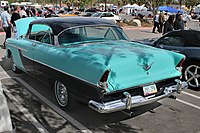
1955 Plymouth Belvedere Sport Coupe

1955 Plymouth Belvedere Sport Coupe

1955 Plymouth Savoy 4-Door Sedan
1955 Plymouth Plaza 4-door Suburban

1956 Plymouth Belvedere 4-door hardtop

1956 Plymouth Plaza
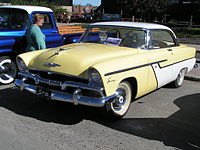
1956 Savoy hardtop coupe
1957–1959[]
| Third generation | |
|---|---|
 1958 Plymouth Belvedere 2-door Hardtop | |
| Overview | |
| Model years | 1957–1959 |
| Assembly | Newark Assembly, Newark, Delaware Lynch Road Assembly, Detroit, Michigan |
| Body and chassis | |
| Body style | 2-door sedan[12] 4-door sedan[12] 2-door hardtop[12] 4-door hardtop[12] 2-door convertible[12] 2-door station wagon[12] 4-door station wagon[12] |
| Related | DeSoto Firedome Dodge Coronet |
| Powertrain | |
| Engine | 230.2 cu in (3.8 L) I6 241 cu in (3.9 L) V8 260 cu in (4.3 L) V8 273 cu in (4.5 L) V8 301 cu in (4.9 L) V8 318 cu in (5.2 L) V8 340 cu in (5.6 L) V8 350 cu in (5.7 L) "Golden Commando" twin 4-barrel V8 |
| Transmission | 2-speed or 3-speed automatic |
| Dimensions | |
| Wheelbase | station wagon: 122.0 in (3,099 mm) all other: 118.0 in (2,997 mm) |
The 1957 model year had high sales for the Chrysler Corporation, and for the Plymouth line. Plymouth's design was so revolutionary that Chrysler used the slogan "Suddenly, it's 1960!" to promote the new car.[13][14]
Standard on all body styles except the convertible was the "Powerflow 6" L-head engine. The convertible was only V8 powered and V8s were available in other Belvederes with an optional "Fury" 301 cu in (4.9 L) version as well as a "High-Performance PowerPAC" at extra cost.[15] A manual transmission was standard with the push-button two-speed PowerFlite optional and the push-button three-speed TorqueFlite automatic also optional on V8 cars. The front suspension introduced Chrysler's Torsion-Aire Torsion bar suspension shared with all Chrysler products starting in 1957. In 1957, Chrysler products offered an appearance of either single or dual headlights. Plymouth installed the headlights in a facia that accommodated dual headlights while offering both single and dual lamps. This appearance can be seen with front turn signal lamps installed inboard, next to the headlight, while vehicles installed with dual headlights offered a concealed turn signal above the headlights in the headlight alcove.
The Belvedere would once again return as a top-level trim for 1958 for the last time. Styling was a continuation of the 1957 models. A big block "B" engine of 350 in3 V8 with dual four-barrel carburetors dubbed "Golden Commando" was optional on all models. For 1959, the Fury became the top range with a full array of sedans and coupes, and the Belvedere became the middle range. The Savoy became the least expensive model, and the Plaza was discontinued.
The convertible was only available in the Belvedere model between 1956 and 1958.
The 1957-58 Belvedere two-door hardtop gained notoriety from the movie Christine (1983) based on the novel by Stephen King. In the opening scene, which the titles set as "Detroit, 1957", Christine appears near the end of the assembly line as a lone bright red car in a long line of Buckskin Beige Furys being built for the new model year (1958). (In the novel it is revealed that her first owner, Roland Lebay had ordered her with custom paint, as the standard 1958 Fury came only in beige.) For the movie, Christine is painted "toreador red" with an "iceberg white" top.
Plymouth Plaza[]
The Plaza was Plymouth's entry-level car during those years and was priced under the Savoy. It was offered in sedan, coupe and wagon variants. Known as Plymouth's "Price Leader", in 1958 the Plaza offered buyers the widest choice of options to date. Options formerly reserved only for higher-priced lines were available on the Plaza for the first time. The Business Coupe, which was the least produced model of Plymouth in 1958 (1,472 units), differed from the regular 2dr Club Sedan in that the rear seat was an optional accessory. Plymouth also added a special edition to the Plaza fleet in '58.
Based on a Plaza Club Sedan, the "Silver Special" had a custom paint job with silver paint on the roof and in the Sportone inserts plus a short stainless steel spear that accented the front fenders and extended partially into the front doors. The final custom touch was on the rear fins where the Silver Special bore "Forward Look" emblems instead of the traditional "Plaza" scripts. It isn't known how many of the 94,728 Plazas produced in 1958 were fitted with the Silver Special trim package, but they are believed to be very rare cars.
Like most models of its kind in the 1950s and 1960s, the Plaza—with its minimal trim and plain cloth-and-vinyl upholstery, and limited option choices—saw most of its appeal toward fleet buyers, such as police departments and other law enforcement agencies, where luxury and comfort were not primary concerns. However, the model was available to budget-conscious private consumers who wanted or needed the room of a full-sized automobile and the availability of such items as a V-8 engine and automatic transmission.
For the 1959 model year, Plymouth discontinued the Plaza and moved the Savoy name down to become the entry level model.[16]
Plymouth Savoy[]
In 1959, Plymouth dropped the Plaza and replaced it with the Savoy, making the Savoy the model's entry level full-size Plymouth. The two previous hardtop models were dropped, as well as the side trim that was more modest called 'Sport Tone', and interior appointments. Sales were not diminished as the Savoy became fleet vehicles used by taxicab companies, police departments and other fleet-minded customers where luxury was not a concern. The model was also available to customers who were in the market for a low-cost, economical vehicle with the availability of a V-8 engine and automatic transmission, and room of a full-size vehicle. By 1960, a new model, the Plymouth Taxi Special, was spun off from the Savoy. Front leg room was 45.5 inches (116 cm).[14]
Plymouth Suburban[]
A new body arrived in 1957, again by Exner. So modern was the design in comparison to the 1956, that Plymouth's ad men proclaimed "Suddenly it's 1960!".[11] Styling on both Suburbans (and the entire line) was cleaner, without the hugely ornate grille castings Plymouths had worn before. The sedans rode on a 118-inch (3,000 mm) wheelbase, and the wagons were 122 inches (3,100 mm). The Suburban was a separate model line in its own right.
Separating the wagons from the other lines was done to limit confusion when ordering parts. Station wagons were growing in popularity, but never matched sedans in volume. Hence there were certain compromises made over the years by all manufacturers. Ford was known to sell Mercury wagons on the shorter Ford wheelbase, particularly in the Comet and Meteor series, and Oldsmobile, Buick and Pontiac Bonneville full size wagons all shared Chevrolet's 119 inch wheelbase for a time (unlike the sedans and coupes on their 123.5 inch wheelbase). Chrysler reversed this. Preferring to maintain the exclusive nature of the Town & Country, the company based all wagons on the larger bodies and smoother suspensions of the senior divisions. This made it difficult for Plymouth to compete in price with Ford and Chevrolet, but did allow them to claim the roomiest wagon in the low-priced field. It also meant the wagons used many parts shared with Chryslers, DeSotos and Dodges, but not other Plymouths. The unique name meant Plymouth dealers were limited in liability; when a mechanic found his new torsion bar was inches too short to fit, he had no one but himself to blame for requesting a Belvedere part instead of a Sport Suburban part.
Suburbans for 1958 were quite similar to those sold in '57, but with detail changes like an under-bumper grille and a V in the grille centre. The P-L-Y-M-O-U-T-H lettering was gone again, replaced by a hood emblem. The rear vision mirror was mounted on the dashboard moved off center toward the driver's side. The old L-head six was available (though not much longer) and there were now three "Dual Fury" V8s; 225 bhp, 250 bhp (4bbl) and 290 bhp (8bbl), as well as a 350cid "Golden Commando" option.
Although based on the same body, 1959 Plymouth Suburbans featured an 'egg-crate' grille and side trim changes, while the front bumper lost its raised centre section and larger tail lamps set the 1958s apart from the rear. Unitary construction was the song being sung of the 1960 Plymouth range. Styling changes included a flat hood from fender to fender, and more pronounced tail fins tacked on the rear. The P-L-Y-M-O-U-T-H lettering returned, along the front of the hood, and a short side flash (for two-toning purposes) finished just after the front wheel arches. A 225cid "Slant Six" replaced the old L-head six - this came from development of the new Valiant V-200 series 'compact' cars.
The separate Suburban series was discontinued for 1962, and the new and now smaller Plymouth station wagon models were instead included within the Savoy, Belvedere and Fury lines.[17] However, the body for the 1961 4-door wagon was held over so that it could be used in the creation of the full-sized Chrysler and Dodge wagons for 1962. The 1962 model Chrysler wagons were created by mating their respective front ends to the updated body of the 1961 Plymouth wagon.[18] Similarly, the Dodge Custom 880 also mated its 1962 front end to the 1961 Plymouth wagon body. The 1961 Plymouth body was utilized because it was the only finless full-sized Chrysler Corporation wagon. The full-sized Chrysler and Dodge wagons would continue to employ this strategy of using updated 1961 Plymouth wagon bodies up through the 1964 model year.

1957 Plymouth Belvedere 4-Door Sedan

1957 Plymouth Plaza 4-Door Sedan
1958 Plymouth Belvedere 4-door sedan

1958 Plymouth Plaza 4-door Sedan

1958 Plymouth Savoy 4-door Sedan
1958 Plymouth Savoy 4-door Sedan

1958 Plymouth Savoy 4-door Sedan interior
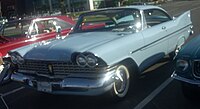
1959 Plymouth Belvedere 2-door hardtop
1959 Plymouth Belvedere 4-door hardtop
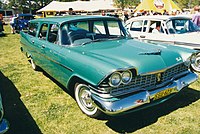
1959 Plymouth DeLuxe Suburban 4-door
1960–1961[]
| Fourth generation | |
|---|---|
 1960 Plymouth Belvedere Sedan | |
| Overview | |
| Also called | Dodge Savoy (Mexico) |
| Model years | 1960–1961 |
| Assembly | Newark Assembly, Newark, Delaware Lynch Road Assembly, Detroit, Michigan |
| Body and chassis | |
| Body style | 2-door sedan[19] 4-door sedan[19] 2-door hardtop[19] 4-door station wagon[19] |
| Related | Dodge Polara Dodge Dart Dodge Matador |
| Powertrain | |
| Engine | 230.2 cu in (3.8 L) I6 241 cu in (3.9 L) V8 260 cu in (4.3 L) V8 273 cu in (4.5 L) V8 318 cu in (5.2 L) V8 340 cu in (5.6 L) V8 350 cu in (5.7 L) "Golden Commando" twin 4-barrel V8 |
| Transmission | 2-speed automatic |
| Dimensions | |
| Wheelbase | 118.0 in (2,997 mm) |
Starting in 1960, Belvederes got a brand-new standard inline six-cylinder engine replacing the venerable valve-in-block "flathead" six. Colloquially known as the Slant Six, it displaced 225 cu in (3.69 l), featured overhead valves, and a block that was inclined 30 degrees to the right to permit a lower hood line with maximum displacement. This engine used a single-barrel Holley carburetor, and became known for its extremely rugged construction, exceptional reliability and longevity. V-8 engines continued to be optionally available, in displacements of 318 cu in (5.21 l) and 361 cu in (5.92 l).
Unit body construction was introduced throughout the line, though it appeared on certain Plymouths in earlier years such as the 1953 hardtop coupe. This eliminated the frame and was advertised as Unibody. Under Chrysler president William Newberg, Virgil Exner's styling team was encouraged to go "over the top" with distinctive styling, leading the 1960 models to be popularly dubbed the "jukebox on wheels" and the 1961 models to be widely considered among the ugliest cars ever mass-produced. Despite being remarkable cars in performance, handling, modest weight, and appealing interiors, sales suffered, and Plymouth yielded third place in sales to Rambler.
Plymouth Suburban[]
In 1961, a year "most beholders would agree...it was hit with the ugly stick",[20] it was available in six models: one two-door and five four-doors, selling at between US$2,604 for the base two-door (style number 255) and US$3,136 for the top four-door (style number 377).[21] It ran on a 122 in (3,100 mm) wheelbase, measured 215 in (550 cm) long, 80 in (200 cm) wide, and 55.4 in (141 cm) high, with standard 7.5 by 14 in (19 by 36 cm) wheels (8 by 14 in (20 by 36 cm) were optional) and blackwall tires.[21] It had a cargo capacity of 95.8 cu ft (2,710 l), with 21 US gal (17 imp gal; 79 l) fuel, and weighed between 3,675 lb (1,667 kg) (for the two-door) and 3,995 lb (1,812 kg) (for the top four-door).[21] It was available with the 225 cu in (3.7 l) slant 6 or 318 cu in (5.2 l) Fury (single four-barrel carburetor), 318 cu in (5.2 l) Super Fury 318 cu in (5.2 l) (dual four-barrel carburetors), 361 cu in (5.9 l) Golden Commando, or 383 cu in (6.3 l) SonoRamic Commando V8.[22] Either three-speed manual or TorqueFlite automatic transmission were available.[22] It was aimed at the Chevrolet Impala/Biscayne, Ford Galaxie, and up-market AMC Ambassador.[21]
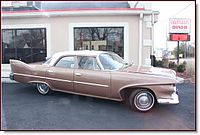
1960 Plymouth Savoy 4-door Sedan

1960 Plymouth Sport Suburban

1961 Plymouth Savoy 4-door Sedan

1961 Plymouth Suburban 4-door station wagon

1961 Plymouth interior
Intermediate series[]
1962–1964[]
| Fifth generation | |
|---|---|
 1962 Plymouth Belvedere Sedan | |
| Overview | |
| Model years | 1962–1964 |
| Assembly | Lynch Road Assembly, Detroit, Michigan Saint Louis Assembly, Fenton, Missouri Los Angeles (Maywood) Assembly, Maywood, California |
| Body and chassis | |
| Body style | 2-door sedan[23] 4-door sedan[23] 2-door hardtop coupe[23] 4-door station wagon[23] |
| Platform | B-body |
| Related | Dodge Polara (1962-1964) |
| Powertrain | |
| Engine | 225 cu in (3.7 L) I6 383 cu in (6.3 L) V8 |
The 1962 model year full-size Plymouths were "downsized", with more compact outside dimensions. American car buyers at the time were in the thought mode of "bigger is better", and sales of these models suffered. However, the smaller Plymouth provided greater owner approval in their actual use.[24] A Plymouth Belvedere with a six-cylinder engine and automatic transmission was compared to the intermediate-size Ford Fairlane and the compact-size Chevrolet Chevy II in an economy test by Popular Mechanics and the road test concluded that the Belvedere was "a very pleasant transportation package."[25] Another advantage of the smaller and lighter body was in drag racing.
The 1963 and 1964 models used the same unibody platform as the 1962s, but were restyled to look longer and wider.
The 1964 Belvedere (and corresponding Fury hardtop coupes) featured a new "slant-back" roofline that proved to be popular, and sales improved significantly over the previous design.
The 1964 Belvedere was also the car used to introduce the 426 Chrysler Hemi engine, which used a canted large-valve arrangement. This was such a significant high-RPM breathing improvement that Hemi-equipped Plymouth Belvederes won first, second, and third at NASCAR's 1964 Daytona race. One of the winning drivers was Richard Petty.[26]
Plymouth Savoy[]
Plymouth discontinued the Savoy nameplate at the end of the 1964 model year, except in Canada, where it continued through 1965.[1]
In 1965, the full-sized entry level Plymouth model in the U.S. was the Fury I; in Canada it was called the Savoy but the top-level models were named Fury II and Fury III.
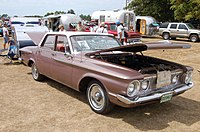
1962 Plymouth Savoy 4-door Sedan

1963 Plymouth Savoy 2-door Sedan

1963 Plymouth Savoy 2-door Sedan with Max Wedge engine option.

1963 Plymouth Savoy 4-Door Station Wagon
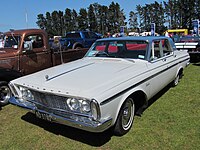
1963 Plymouth Belvedere 4-Door Sedan

1964 Plymouth Savoy Four-Door Sedan

1964 Plymouth Belvedere 4-door sedan
1965–1967[]
| Sixth generation | |
|---|---|
 1967 Plymouth Belvedere II 4-door sedan | |
| Overview | |
| Model years | 1965–1967 |
| Assembly | Lynch Road Assembly, Detroit, Michigan Saint Louis Assembly, Fenton, Missouri Los Angeles Assembly, Maywood, California |
| Body and chassis | |
| Body style | 2-door sedan[27] 4-door sedan[27] 2-door hardtop[27] 2-door convertible 4-door station wagon[27] |
| Platform | B-body |
| Related | Dodge Coronet |
| Powertrain | |
| Engine | 225 cu in (3.7 L) Slant-6 I6 273 cu in (4.5 L) LA V8 |
| Transmission | 3-speed A903 manual 3-speed A727 automatic |
In 1965 Plymouth once again made the Fury a full-size car, and Belvedere ostensibly became the intermediate size offering, though the Belvedere was little changed, and most dimensions and weights remained the same—the Fury was merely enlarged, restoring a full-sized line which Plymouth had been lacking.[28] The Belvedere line was divided into the Belvedere I, Belvedere II and Satellite subseries, the latter available only as hardtop coupe and convertible, and featuring the 273 cu in (4.47 l) "LA block" V8 as standard equipment. The line was restyled in 1966, and the high-performance GTX was added in 1967.
The pilot episode for the television show Adam-12 featured a 1967 Belvedere as the standard LAPD police cruiser.
Engines[]
| Model Year | Displacement, Designation, Carburetor | Power | Torque |
|---|---|---|---|
| 1965-1967 | 225 cu in (3.7 L) Slant-6 I6 1-Barrel | 145 hp (108 kW; 147 PS) | 215 lb⋅ft (292 N⋅m) |
| 1965-1967 | 273 cu in (4.5 L) LA V8 2-Barrel | 180 hp (134 kW; 182 PS) | 260 lb⋅ft (353 N⋅m) |
| 1965-1967 | 318 cu in (5.2 L) LA V8 2-Barrel | 230 hp (172 kW; 233 PS) | 340 lb⋅ft (461 N⋅m) |
| 1965 | 361 cu in (5.9 L) B V8 2-Barrel | 265 hp (198 kW; 269 PS) | 380 lb⋅ft (515 N⋅m) |
| 1967 | 383 cu in (6.3 L) B V8 2-Barrel | 270 hp (201 kW; 274 PS) | 390 lb⋅ft (529 N⋅m) |
| 1965-1967 | 383 cu in (6.3 L) B V8 4-Barrel | 325 hp (242 kW; 330 PS) | 425 lb⋅ft (576 N⋅m) |
| 1965 | 426 cu in (7.0 L) Wedge V8 4-Barrel | 365 hp (272 kW; 370 PS) | 470 lb⋅ft (637 N⋅m) |
| 1967 | 426 cu in (7.0 L) Hemi V8 2x4-Barrel | 425 hp (317 kW; 431 PS) | 490 lb⋅ft (664 N⋅m) |
| 1967 | 440 cu in (7.2 L) RB V8 4-Barrel | 375 hp (280 kW; 380 PS) | 480 lb⋅ft (651 N⋅m) |
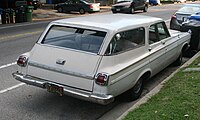
1965 Plymouth Belvedere II wagon

1966 Plymouth Belvedere Satellite 2-door hardtop
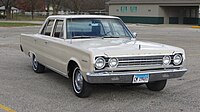
1967 Plymouth Belvedere I 4-door sedan
1968–1970[]
| Seventh generation | |
|---|---|
 1968 Plymouth Satellite | |
| Overview | |
| Model years | 1968–1970 |
| Assembly | Lynch Road Assembly, Detroit, Michigan Saint Louis Assembly, Fenton, Missouri Los Angeles Assembly, Maywood, California |
| Body and chassis | |
| Body style | 2-door coupe[29] 4-door sedan[29] 4-door station wagon[29] |
| Platform | B-body |
| Powertrain | |
| Engine | 273 cu in (4.5 L) V8 383 cu in (6.3 L) V8 318 cu in (5.2 L) V8 340 cu in (5.6 L) V8 426 cu in (7.0 L) Hemi V8 |
| Dimensions | |
| Wheelbase | 116.0 in (2,946 mm) |
| Length | 202.7 in (5,149 mm) |
| Width | 76.4 in (1,941 mm) |
| Height | 54.7 in (1,389 mm) |
In 1968, the Belvedere - along with the rest of Chrysler's B-body offerings - was reskinned with "Coke bottle styling." The Belvedere II was dropped, but the Sport Satellite was added to the overall lineup, using the same sheet metal.
The new LA-style lightweight 318 engine was introduced for this year and would remain available on the Belvedere through its life. The Plymouth Road Runner was introduced as a low-price, high-performance alternative to the GTX, and Richard Petty won the Grand National championship in NASCAR in a Belvedere. However the GTX came standard with the 440 CID engine and the Road Runner with the 383 Magnum, with the 440 six-barrel or the 426 HEMI engines optional.
The Belvedere name was dropped at the end of the 1970 model year, replaced by the Satellite name originally reserved for higher-end Belvederes. It lasted only through 1974, becoming the Fury in 1975 when the longer-wheelbase Fury model became the Gran Fury.
Police[]
Belvederes were used in police service from the late 1960s to the early 1970s, when they were replaced by the Plymouth Gran Fury. They were prominent in both the LAPD and New York Police Department.
Australian production[]


The Plymouth Belvedere was also produced by Chrysler Australia. The first model, based on the 1953 US Plymouth, featured a high level of Australian content, with body panels pressed in Chrysler Australia's Keswick facility in South Australia and matched with a 217.8 cubic inch (4107cc) side-valve six-cylinder engine, imported from Chrysler UK.[30] It was produced as a four-door sedan[30] and as a locally developed two-door coupe utility,[31] along with similar Cranbrook and Savoy models, until it was replaced by the Chrysler Royal in 1957.[30] The Belvedere was reintroduced to the Australian market in early 1958 when Chrysler Australia began assembling the current model Belvedere four-door hardtop which was imported from the US in knocked-down form.[32] The 1959 model was equipped with a 318 cubic inch V8 engine and push-button automatic transmission.[33] Chrysler Australia replaced their Plymouth Belvedere, Dodge Custom Royal and De Soto Firesweep models with the Dodge Phoenix in 1960.[34] Chrysler Australia produced the P25 series Plymouth Savoy from 1954 to 1957.[35] An Australian developed coupe utility variant of the Savoy was produced from 1956 to 1958.[36]
Oklahoma centennial[]
During Oklahoma's 50th anniversary, a new 1957 Plymouth Belvedere was sealed in a concrete enclosure as a time capsule in downtown Tulsa on the grounds of the brand new county courthouse. It was unearthed June 14, 2007[37] during the state's centennial celebrations, and was publicly unveiled on June 15. In line with the Cold War realities of late 1950s America, the concrete enclosure was advertised as having been built to withstand a nuclear attack.[38] The concrete enclosure, however, was not airtight and allowed water to leak in, which caused significant damage to the vehicle.[39]
The controversial[40] televised vehicle customizer Boyd Coddington was to have been the first to start the unburied car, had it been operable.
The car was the prize of a 1957 contest to guess the population of Tulsa in the year 2007. The winning entrant, one Raymond Humbertson, guessed 384,743 versus the actual figure of 382,457. However, Humbertson died in 1979 and now only distant relatives remain.[41]
A second car, this time a Plymouth Prowler, was encased in a vault in Tulsa's Centennial Park (formerly Central Park) in 1998 to celebrate the city's centennial. After it was discovered what had become of the 1957 Belvedere, the Prowler was moved above ground, and a mound was formed over it. It is to be revealed after the same period of time as the Belvedere, in 2048.
Notes[]
- ^ Jump up to: a b c Consumer Guide, Auto Editors of (1989). 50 Years of American Automobiles. New York: Beekman House. p. 319-322. ISBN 0-517-68640-6.
- ^ Gunnell, John. Standard Catalog of American Cars 1946-1975 (Fourth ed.). pp. 646–649.
- ^ Jump up to: a b c d e John Gunnell, Standard Catalog of American Cars 1946-1975, Revised 4th Edition, page 650
- ^ "1954 Plymouth foldout, models". oldcarbrochures.org. Archived from the original on 3 March 2016. Retrieved 13 October 2014.
- ^ Jump up to: a b c d e f John Gunnell, Standard Catalog of American Cars 1946-1975, Revised 4th Edition, page 650-653
- ^ Zavitz, R. Perry (1990). "The Postwar Plymouths Changing Personalities From Staid to Flashy". In Lee, John (ed.). Standard Catalog of Chrysler, 1924-1990. Iola, WI: Krause Publications, Inc. p. 119. ISBN 0-87341-142-0.
- ^ "1956 Plymouth brochure" Check
|archive-url=value (help). Oldcarbrochures.com. Archived from the original on September 30, 2010. Retrieved 2011-11-20. - ^ "We Drove A Turbine Car Coast-To-Coast." Popular Mechanics, June 1956, pp. 72-76/252.
- ^ Jump up to: a b John Gunnell, Standard Catalog of American Cars 1946–1975, Revised 4th Edition, page 652
- ^ 1956 Plymouth Suburban Brochure, oldcarbrochures.org Archived 2016-03-04 at the Wayback Machine Retrieved 12 October 2015
- ^ Jump up to: a b c Consumer Guide: Cars Of The 50s, page 75
- ^ Jump up to: a b c d e f g John Gunnell, Standard Catalog of American Cars 1946-1975, Revised 4th Edition, pages 653-655
- ^ "1957 Plymouth prestige brochure". oldcarbrochures.org. pp. 2–3. Archived from the original on 9 May 2016. Retrieved 26 April 2016.
- ^ Jump up to: a b "1959 Plymouth brochure". Oldcarbrochures.com. Retrieved 13 October 2014.
- ^ "Specifications: 1957 Plymouth brochure". oldcarbrochures.org. p. 12. Archived from the original on 9 May 2016. Retrieved 26 April 2016.
- ^ John Gunnell, Standard Catalog of American Cars 1946-1975, Revised 4th Edition, page 655
- ^ 1962 Plymouth Full Size Brochure, www.oldcarbrochures.com Retrieved 6 May 2020
- ^ Godshall, Jeffrey I. (December 1994). "1960-62 Chrysler "Positively No Jr. Editions"". Collectible Automobile. Vol. 11 no. 4. pp. 53–54.
- ^ Jump up to: a b c d John Gunnell, Standard Catalog of American Cars 1946-1975, Revised 4th Edition, pages 656-659
- ^ Flory, p.123.
- ^ Jump up to: a b c d Flory, p.127.
- ^ Jump up to: a b Flory, p.124.
- ^ Jump up to: a b c d John Gunnell, Standard Catalog of American Cars 1946-1975, Revised 4th Edition, pages 660-665
- ^ "Smaller Plymouth wins greater owner approval". Popular Mechanics. 117 (2): 95–99, 246, 248, 250. February 1962. Retrieved 2 October 2015.
- ^ Whipple, James (January 1962). "Drive Comparing Ford Fairlane, Plymouth Belvedere, Chevy II". Popular Mechanics. 117 (1): 104–108, 244, 245. Retrieved 2 October 2015.
- ^ Redgap, Curtis (2003). "Which came first, the Plymouth or the Petty?". Allpar. Retrieved 2 October 2015.
- ^ Jump up to: a b c d Gunnell, John, ed. (1987). The Standard Catalog of American Cars 1946-1975. Krause Publications. pp. 665–671. ISBN 978-0-87341-096-0.
- ^ Auto Editors of Consumer Guide (6 December 2007). "1965, 1966, 1967 Plymouth Belvedere/Satellite and GTX". HowStuffWorks. Retrieved 2011-04-20.
- ^ Jump up to: a b c John Gunnell, Standard Catalog of American Cars 1946-1975, Revised 4th Edition, pages 671-678
- ^ Jump up to: a b c David Brimble, Chryslers before the Chrysler Royal, Restored Cars, No 87 (July / August 1991), pages 14-15
- ^ Larry O'Toole, The Good Old Aussie Ute, page 192
- ^ Gavin Farmer, Great Ideas in Motion, 2010, page 74
- ^ News Review, Three Chryslers, Australian Motor Sports, August 1959
- ^ Gavin Farmer, Great Ideas in Motion, 2010, page 77
- ^ Gavin Farmer, Great Ideas in Motion, 2010, pages 23 to 25
- ^ Automotive oddity website, www.roadkillontheweb.com Retrieved 1 March 2016
- ^ http://www.unburiedcar.com
- ^ CNN: link broke. Archived July 6, 2007, at the Wayback Machine
- ^ World staff. "Buried Belvedere vault full of water". TulsaWorld. Archived from the original on 2013-02-04. Retrieved 2011-11-20.
- ^ "Updated: Belvedere rusty but still has personality". TulsaWorld. 2007-06-15. Archived from the original on 2011-09-27. Retrieved 2011-11-20.
- ^ "Miss Belvedere, you have a winner: But Raymond Humbertson died in 1979". TulsaWorld. 2007-06-23. Archived from the original on 2013-02-05. Retrieved 2011-11-20.
External links[]
| Wikimedia Commons has media related to Plymouth Belvedere. |
- Allpar: Plymouth Satellite, Plymouth GTX, and Plymouth Belvedere
- View the Unburied Plymouth Belvedere
- Plymouth Belvedere in television and film
- Plymouth sales brochures at www.oldcarbrochures.com
- Members cars, page 3, The WPC Club, Inc.
- "Plymouth Combination Station Wagon And Utility Vehicle" Popular Mechanics, July 1949
| show |
|---|
- Plymouth vehicles
- Cars introduced in 1954
- 1960s cars
- 1970s cars
- Convertibles
- Coupés
- Full-size vehicles
- Mid-size cars
- Police vehicles
- Rear-wheel-drive vehicles
- Sedans
- Station wagons



































